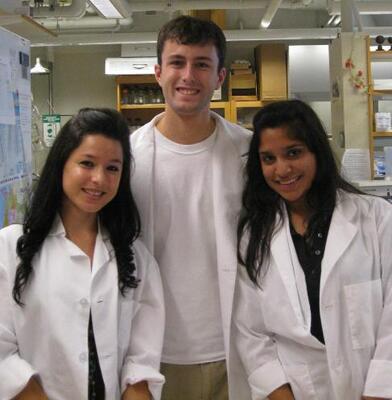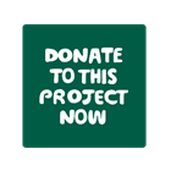Una Salud / one health
|
UNA SALUD / ONE HEALTH program of the FUCOBI Foundation is directed by Dr. Acacia Alcivar-Warren, D.M.V.Z, M.Sc., Ph.D., former President of FUCOBI. She has worked since 1998 on projects based on the holistic concept of ONE HEALTH in the Philippines, Thailand and other countries. Being part of the UNA SALUD / ONE HEALTH Program. You can participate in the following activities, classified following the holistic paradigm of the program: Conserve Healthy Ecosystems, to maintain Healthy Animals and protect Public Health in the long term.
|
 Daniela Espinoza, Jeremy Vincent, y Shana Singh
Daniela Espinoza, Jeremy Vincent, y Shana Singh
1. MangroveEncode / Mangrove Ecosystem Health
a. Promote the reforestation of mangroves using ecological engineering techniques approved by international scientists (Lewis 2007). This is very important because reforestation programs by shrimp farmers have already started in some places in Ecuador, and we believe that some changes should be made immediately. For example, in a shrimp farm in El Palmar, Santa Elena, the mangrove species that was being used for reforestation was brought from Esmeraldas and this is not appropriate if you really want to maintain the original biodiversity of the mangrove.
b. Take inventory of the plants and animals that live together with the mangrove species.
c. Collect samples of mangrove roots and accompanying diversity in the mangrove to analyze the levels of metals and persistent organic pollutants (POPs). We have permission from the MAE to collect samples in protected areas. We collected some samples of known mangrove species in Ecuador in July 2010, and we need students to continue this study.
d. Confirm the number of mangrove species along the coast of Ecuador and the Galapagos Islands, using modern taxonomic, systematic, molecular and genomic and epigenetic technology.
e. Isolate DNA and RNA from mangrove and accompanying diversity samples collected in 2010 and 2011. Aliquots of DNA and RNA are distributed to all interested collaborators.
f. Examine the genetic diversity of mangroves in Ecuador using genetic and epigenetic markers, according to the project approved by the MAE.
g. Establish a database with information on the pollutant load in mangroves and accompanying diversity, mangrove sediment and water along the coast of Ecuador. We collect information on the following parameters: nitrite, nitrate, phosphate, heavy metals (lead, cadmium, mercury, zinc, nickel, chromium, among others) and POPs such as hexachlorobenzene, DDT and its derivatives, Dieldrin, Dioxin, polycyclic aromatic hydrocarbons (HAPs ) , among others.
h. Obtain mangrove cDNA libraries containing the highest and lowest levels of pollutant charge (metals and POPs), in order to study gene expression (transcriptome) under different environmental conditions. i. Perform Metagenomics studies in sediments and soils of Ecuador with differences in metals and POPs.
j. Write projects to carry out the analysis of heavy metals and POPs in mangrove roots, sediment, shellfish and water in a laboratory of international prestige in order to maintain transparency in the UNA SALUD/ ONE HEALTH program, since Dr. Alcivar-Warren also manages similar projects in other countries. This will allow comparative studies with relevant statistical and epidemiological significance.
h. Environmental Justice on environmental pollutants (metals and POPs) in rivers, estuaries and soil. Carry out plastic cleaning in the mangroves, as well as establish a database on the waste of pollutants.
2. ShrimpEncode / Animal Health
a. Monitor the accompanying diversity of shrimp in estuaries along the coast of Ecuador and in the Galapagos Islands. Make an inventory of all the species collected in the network, following the protocol described in the permit granted by the MAE. Program in progress.
b. Examine the genetic diversity in fish, cattle and other species of Ecuador, using genomic and epigenetic markers.
c. Study the prevalence of diseases in fish, shellfish, livestock, birds and other species in Ecuador.
d. Examine levels of glucose, cholesterol, HDL, LDL, triglycerides, uric acid, TGP / ALT, TGO / AST, Creatinine, in seafood and fish from Ecuador.
e. Monitor the load of pollutants (Metals and POPs, Antibiotics) shellfish, fish, vegetables, livestock and other species of interest to students.
f. To study genetic diversity and determine the prevalence of viral diseases in blue shrimp, Litopenaeus stylirostris, in order to develop a commercial line for the benefit of the mangrove inhabitants.
g. Develop a genetic improvement program for L. stylirostris using genomic biology technique to develop organic lines (without metals and POPs) and commercialize them through a collaboration between FUCOBI, the families living in the mangrove swamp, and foreign organizations that help marketing of local products produced in a sustainable way.
h. Create a fish and shrimp gene bank - Litopenaeus vannamei embryo and sperm freezing.
3. ChrildrenEncode / Public Health
a. Conduct surveys to determine the food consumption of families living in the mangroves in collaboration with local Doctors and Universities.
b. Monitor complete blood parameters (CBC) and measurement of blood chemistry (glucose, cholesterol, HDL, LDL, triglycerides, uric acid, TGP / ALT, TGO / AST, creatinine) in mangrove inhabitants in collaboration with local Doctors and Universities.
c. Study the relationship between the consumption of food contaminated at low levels with metals / POPs and the health of the inhabitants.
a. Promote the reforestation of mangroves using ecological engineering techniques approved by international scientists (Lewis 2007). This is very important because reforestation programs by shrimp farmers have already started in some places in Ecuador, and we believe that some changes should be made immediately. For example, in a shrimp farm in El Palmar, Santa Elena, the mangrove species that was being used for reforestation was brought from Esmeraldas and this is not appropriate if you really want to maintain the original biodiversity of the mangrove.
b. Take inventory of the plants and animals that live together with the mangrove species.
c. Collect samples of mangrove roots and accompanying diversity in the mangrove to analyze the levels of metals and persistent organic pollutants (POPs). We have permission from the MAE to collect samples in protected areas. We collected some samples of known mangrove species in Ecuador in July 2010, and we need students to continue this study.
d. Confirm the number of mangrove species along the coast of Ecuador and the Galapagos Islands, using modern taxonomic, systematic, molecular and genomic and epigenetic technology.
e. Isolate DNA and RNA from mangrove and accompanying diversity samples collected in 2010 and 2011. Aliquots of DNA and RNA are distributed to all interested collaborators.
f. Examine the genetic diversity of mangroves in Ecuador using genetic and epigenetic markers, according to the project approved by the MAE.
g. Establish a database with information on the pollutant load in mangroves and accompanying diversity, mangrove sediment and water along the coast of Ecuador. We collect information on the following parameters: nitrite, nitrate, phosphate, heavy metals (lead, cadmium, mercury, zinc, nickel, chromium, among others) and POPs such as hexachlorobenzene, DDT and its derivatives, Dieldrin, Dioxin, polycyclic aromatic hydrocarbons (HAPs ) , among others.
h. Obtain mangrove cDNA libraries containing the highest and lowest levels of pollutant charge (metals and POPs), in order to study gene expression (transcriptome) under different environmental conditions. i. Perform Metagenomics studies in sediments and soils of Ecuador with differences in metals and POPs.
j. Write projects to carry out the analysis of heavy metals and POPs in mangrove roots, sediment, shellfish and water in a laboratory of international prestige in order to maintain transparency in the UNA SALUD/ ONE HEALTH program, since Dr. Alcivar-Warren also manages similar projects in other countries. This will allow comparative studies with relevant statistical and epidemiological significance.
h. Environmental Justice on environmental pollutants (metals and POPs) in rivers, estuaries and soil. Carry out plastic cleaning in the mangroves, as well as establish a database on the waste of pollutants.
2. ShrimpEncode / Animal Health
a. Monitor the accompanying diversity of shrimp in estuaries along the coast of Ecuador and in the Galapagos Islands. Make an inventory of all the species collected in the network, following the protocol described in the permit granted by the MAE. Program in progress.
b. Examine the genetic diversity in fish, cattle and other species of Ecuador, using genomic and epigenetic markers.
c. Study the prevalence of diseases in fish, shellfish, livestock, birds and other species in Ecuador.
d. Examine levels of glucose, cholesterol, HDL, LDL, triglycerides, uric acid, TGP / ALT, TGO / AST, Creatinine, in seafood and fish from Ecuador.
e. Monitor the load of pollutants (Metals and POPs, Antibiotics) shellfish, fish, vegetables, livestock and other species of interest to students.
f. To study genetic diversity and determine the prevalence of viral diseases in blue shrimp, Litopenaeus stylirostris, in order to develop a commercial line for the benefit of the mangrove inhabitants.
g. Develop a genetic improvement program for L. stylirostris using genomic biology technique to develop organic lines (without metals and POPs) and commercialize them through a collaboration between FUCOBI, the families living in the mangrove swamp, and foreign organizations that help marketing of local products produced in a sustainable way.
h. Create a fish and shrimp gene bank - Litopenaeus vannamei embryo and sperm freezing.
3. ChrildrenEncode / Public Health
a. Conduct surveys to determine the food consumption of families living in the mangroves in collaboration with local Doctors and Universities.
b. Monitor complete blood parameters (CBC) and measurement of blood chemistry (glucose, cholesterol, HDL, LDL, triglycerides, uric acid, TGP / ALT, TGO / AST, creatinine) in mangrove inhabitants in collaboration with local Doctors and Universities.
c. Study the relationship between the consumption of food contaminated at low levels with metals / POPs and the health of the inhabitants.
UNA SALUD / ONE HEALTH project can be carried out with other animal species such as cattle, wild species, viruses (foot-and-mouth disease, IHHNV, TSV), bacteria (vibrios), POPs, metals, or combining marine and terrestrial species at the same time . The technology that you will learn is the same for all species, the most difficult thing is to understand the complexity of the interaction between the environmental factors involved in ecosystem health, animal health and public health.

